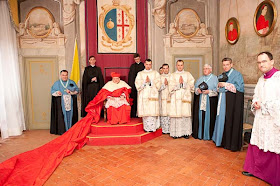After my previous post about Cappa Magna I would like to draw more attention to this symbolic vestment that is rarely understood in modern times. First we have to understand that Church communicates using symbols that have inner meaning expressing certain ideas. Without accepting this statement all symbols in the liturgy, objects and other actions will be just esthetic and empty thing.
If we do not accept functions of symbolism, Cappa Magna is funny, meaningless object and it is useless to read next part of this text.
However, if we accept use and function of symbols, we must try to understand it, which would enrich our reality, instead of getting rid of it.
I have found an interesting definition and symbolism of Cappa Magna:
But still, this definition does not convince people to this garment. There must be something more that makes so much noise around that:
Liberté – in the Church we are not free, we are voluntarily God’s slaves, slaves of His law, slaves of His Liturgy, slaves of Rubrics. We do not discuss on what people will say, we just follow the rules.
Égalité – in the Church WE ARE NOT EQUAL, in any way. We are Hierarchical. One depends on the other. And Cappa Magna is a sign of jurisdiction. It is worn only by bishops in their own diocese, by abbots in their abbey, by Cardinals all over the World and by Pope (once a year, but still).
Moreover, the Church is monarchical. The Pope is also a King (yes, he is), the Cardinals and bishops are princes of the Church (abbots are Dukes ;-). So the association of Cappa Magna with ‘dress of monarchs’ is pretty accurate. It will not be accepted, because they would rather see Bishops a pastors and not rulers.
Will they like Cappa Magna ever? NO, they will not, in the same way as they will not like hierarchy, monarchy and differences between people. Because they hate all authority, they hate all symbols and superiority of all kind, which Cappa Magna represents.
If we do not accept functions of symbolism, Cappa Magna is funny, meaningless object and it is useless to read next part of this text.
However, if we accept use and function of symbols, we must try to understand it, which would enrich our reality, instead of getting rid of it.
I have found an interesting definition and symbolism of Cappa Magna:
“The Cappa Magna does indeed represent the finery of the world, its power and prestige. That is why after his entrance wearing it, the prelate is publicly stripped of this finery and humbled before the congregation. Then, vestment by vestment, the bishop is clothed in the new man of which St Paul speaks, including the baptismal alba, the dalmatic of charity, the stole of pardon and the chasuble of mercy. When finally clothed in Christ, the prelate makes a second entrance into the church to begin the Eucharistic celebration in persona Christi, the visible head of the body, the church.Clear, precise and quite true.
It was a clear statement that the power and prestige of the world have no place at the altar, but it is expressed in a liturgical ritual or symbol, which, unfortunately, are often lacking in the contemporary rites and thus hard to grasp”.
But still, this definition does not convince people to this garment. There must be something more that makes so much noise around that:
“The Cappa Magna may have been appropriate in another age and in another time, but not today. Our bishops are meant to be pastors not princes.”
“It's still the dress of monarchs”
“The cappa magna, regardless of its former intent makes the cleric the point of the liturgies and not the assembly with the sacrament.”And these are the point why the world hates and will never like Cappa Magna - it represents what actually the Church is: Proud of its traditions and Hierarchical. Cappa Magna is a symbol that opposes to two revolutionary statements:
Liberté – in the Church we are not free, we are voluntarily God’s slaves, slaves of His law, slaves of His Liturgy, slaves of Rubrics. We do not discuss on what people will say, we just follow the rules.
Égalité – in the Church WE ARE NOT EQUAL, in any way. We are Hierarchical. One depends on the other. And Cappa Magna is a sign of jurisdiction. It is worn only by bishops in their own diocese, by abbots in their abbey, by Cardinals all over the World and by Pope (once a year, but still).
Moreover, the Church is monarchical. The Pope is also a King (yes, he is), the Cardinals and bishops are princes of the Church (abbots are Dukes ;-). So the association of Cappa Magna with ‘dress of monarchs’ is pretty accurate. It will not be accepted, because they would rather see Bishops a pastors and not rulers.
 |




Isaiah 6:1
ReplyDelete"In the year that king Uzziah died I saw also the Lord sitting upon a throne, high and lifted up, and his train filled the temple."